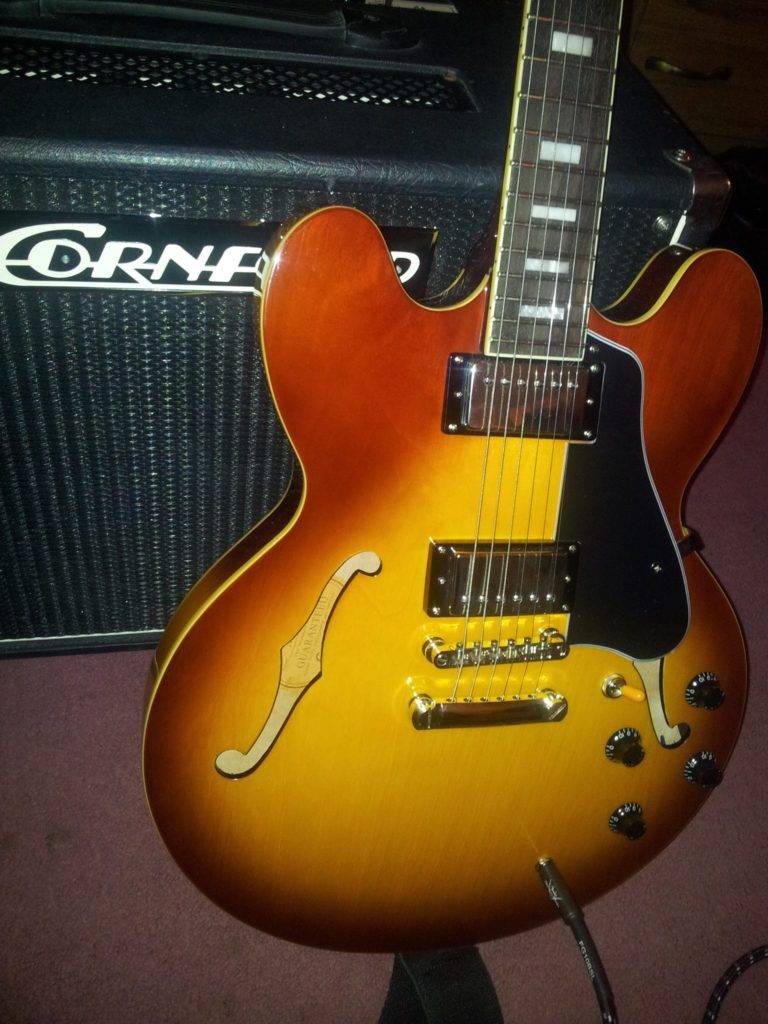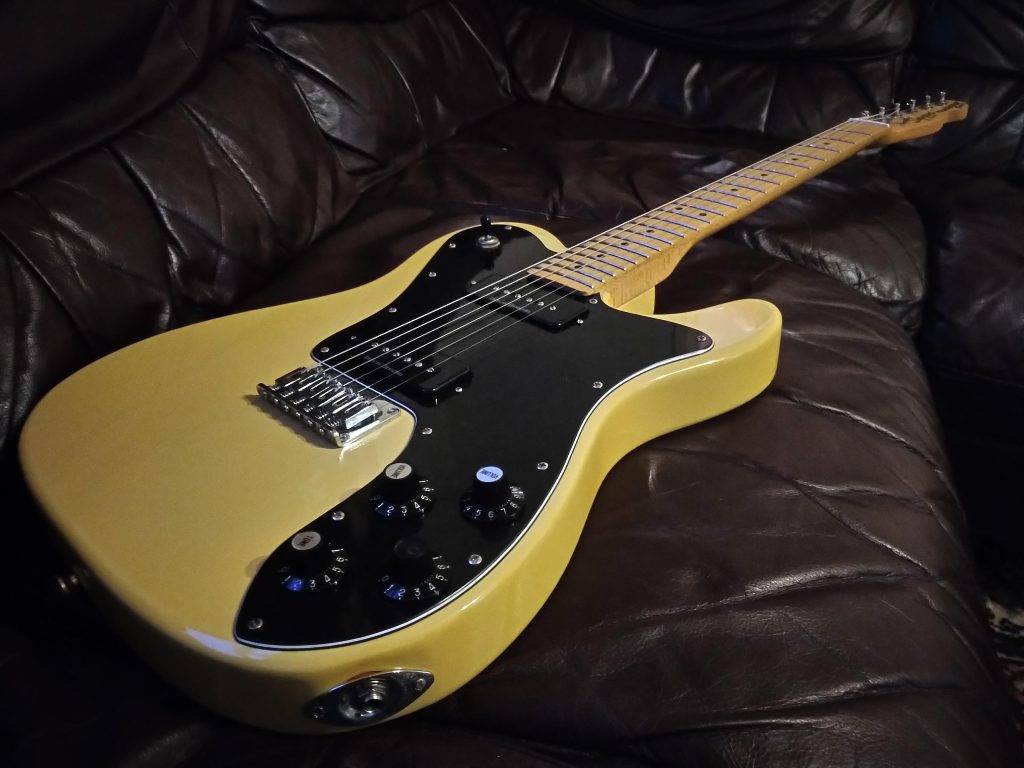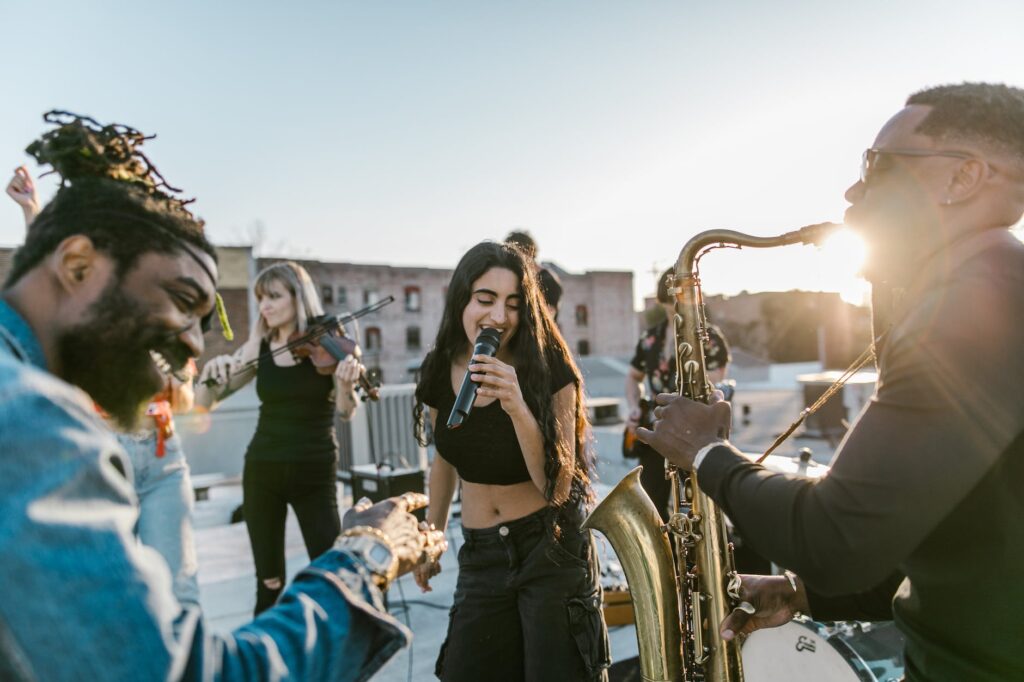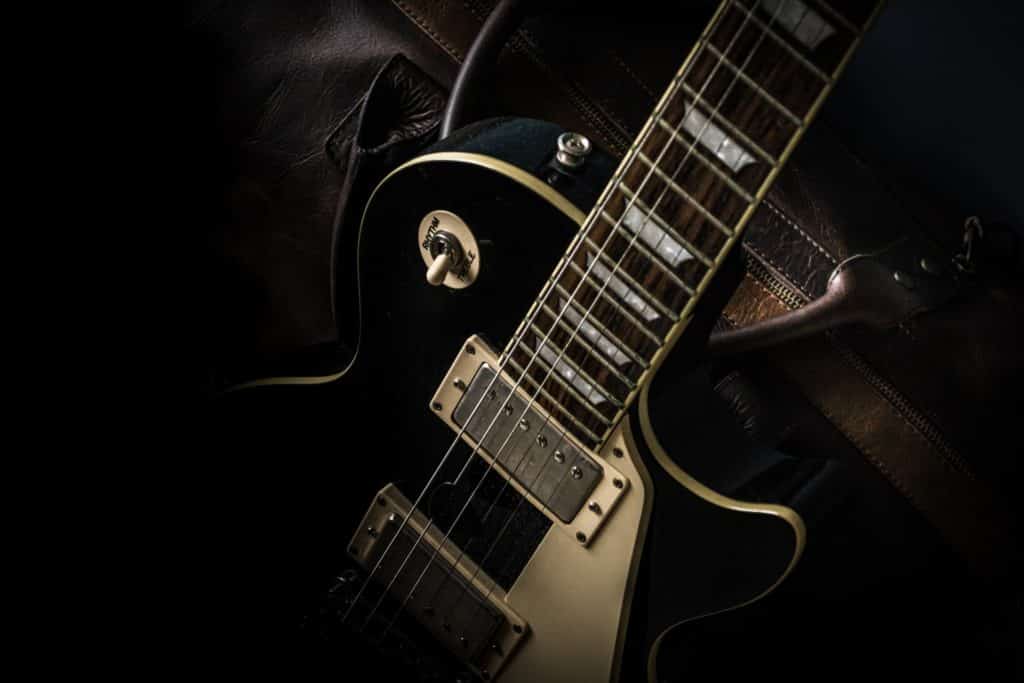An inventory of every single electric guitar I’ve owned since I started in 1990. My very own Electric Guitar History. What’s your Electric Guitar History?
Hondo Strat copy
My electric guitar history begins as a Christmas present circa my 16th Birthday, 1990. Candy apple red with a rosewood fingerboard. It didn’t inspire and as such I didn’t really make any progress on guitar with it
Fender Japanese Strat (80s)
In my college years I started a love-hate relationship with another candy -apple red strat. This time with a maple fingerboard. Purchase form McKays music in Newcastle circa 1990. It was either this or a black USA hard-tail for around £50 more. Bad decision.
The Bad? Well that god-awful Fender-branded floyd rose-type bridge + locking nut. It never stayed in tune and strings would often break on full-tone bends.
The Good? The neck and a Fender Champion 15 introduced me to that famed ‘Brown Sound’, where the guitar seems to play itself. I’ve searched my whole life to get back to that.
Epiphone LP 100 Ebony
As I got into semi-serious gigging I knew the Strat couldn’t be relied upon. I needed something solid.
Trading the Japanese strat in for the Epi was beyond foolish financially, considering how much they’re worth now, but I was still learning the ropes.
In practice this Epi was a great introduction to the world of Les Pauls, The loose top end-pin was a constant nuisance though.
In hindsight, the end-pin could have easily been sorted with the old matchsticks + wood glue trick, but by that time I hankered for a step up anyway.
1972 USA Fender Telecaster
I had a loan of this for two weeks and honestly didn’t get on with it. The fingerboard was too narrow and worn. In fairness I didn’t have the amplification to do it justice at the time, but it’s tinny nature meant I wasn’t too devastated to give it back. How little I knew back then…
Hohner Les Paul Goldtop p90s
Love at first sight. A Gold Top with P90s. A surprisingly great guitar with a spiteful bridge pickup and classic thick/flutey p90 neck. I covered a lot of sonic ground with this guitar both for gigs and recording.
In the end the tuners and nut let me down and the issue of tuning stability raised it’s head. I’d also saw a rave review for a Tanglewood Chicago semi-acoustic in Guitarist, so the writing was on the wall.
Still, I had this Hohner to thank for getting me upto speed gigging and recording wise.
The Hohner features on a favourite song of I wrote: Dance right through the night.
Fender Mexican Strat (90s)
Not having given up with Strats quite yet, I happened upon a black Mexican Fender Strat with a rosewood fingerboard.
One word: Vanilla. In absolutely all regards.
A thoroughly workaday, uninspiring, boring instrument. Mexican instruments are so much better today.
Tanglewood Chicago
So at last the time came to trade up the Hohner and the Fender for the object of my desires. A Cherry red Tanglewood Chicago semi-acoustic.
To begin with, it pretty much did the job as a versatile, great sounding instrument, but alas, the build quality was a little rough around the edges.
The gold-plated hardware had begun to tarnish roughly, I would catch my hand in the upper registers of the neck join.
Eventually all those little distractions added up to a big pain, but it didn’t stop me wallowing in it’s unpredictable world of massive sustain and versatiliy.
So far, this and the Hohner were the only two guitars I really clicked with, and advanced on.
Yamaha Pacifica 112 (90s – Japan)
This new Yamaha Pacifica 112 in shell white was anything but a pain. Build quality was absolutely spot on, and that humbucker at the bridge provided a great bit of grunt.
All the reliability, great tuning stability, but no spark, and once I started to gig with it, well, it sort of got lost in the mix.
Gibson Les Paul Standard (1998)
My first ‘real’ guitar. At the time I had the funds to go out and choose whatever I liked. So it had to be ‘The Standard‘. I tried out a number of others in the store, but this ebony model seemed to sound the best to me.
Of course it was an amazingly powerful-sounding instrument, with a thick, woody tone. Just the tone I was after. I stuck with it for around about a year or so, but never gigged it as I wasn’t in a band at the time.
I suppose I just got a little tired of it’s lack of versatility. It did the powerful bridge humbucker thing. It did the woman tone Sweet Child ‘o Mine intro. I just yearned for more versatility and a more modern ride.
Would I have another one today? Absolutely. Do I wish I’d kept it? Yup.
I suppose at the time my though process was, I’d tried the best of Gibson, now to the best of Fender.
Back to strats then?
I’ll never forger some my own songs that we’re recored using this guitar, The Indian in particular.
I’ve never really got back to that signature clean but on the edge Les Paul tone since.
Fender USA American Standard Strat (1997)
The second (and last) massive trade-in rip-off. As my one-year-old Gibson Les Paul Standard was traded in for a second hand USA Stratocaster in a darkish pearl blue, with a rosewood fingerboard.
The Strat could have been the perfect guitar. Widely acknlowledged as being a good era for Strats, with a ‘strident’ tone, it most all the sounds of the Gibson but with far greater playability and versatility, it’s just that it needed a fret-level I couldn’t afford at the time.
What a shame, but by now my bad luck with strats had moved me over to the Gibson-style camp for the foreseeable future at least.
An important lesson in my electric guitar history. How I wish i’d kept that Gibson Les Paul Standard.
Gordon Smith Graduate 60
This ruby red beauty seemed to tick a lot of boxes. It had the power of the Les Paul, but with the versatility of coil-taps and slick playability.
It absolutely worked as I got back into serious gigging again around 2003, I only wish I had got my hands on a newer model as the fingerboard was deteriorating rapidly and the adjustable brass nut had seen better days.
Overall the Gordon Smith seemed to be thrown together on someones work-bench rather than a precision engineered.
A little too rough and ready.
Gibson Les Paul Studio 2003

As so to the guitar I owned the longest in my electric guitar history. Could the Les Paul Studio be the answer? For the next 10 years at least, Yes!
Read the full story Gibson Les Paul Studio Review
Epiphone Les Paul Standard 2003
Beautiful light sunburst. I upgraded it with a Seymour Duncan 59 (Neck), JB (Bridge) and a switchcraft toggle switch.
It was a trusty sidekick/backup for the Les Paul, but never had the former’s mojo.
Also features here: Gibson Les Paul Studio Review
PRS SE soapbar II
My quest to go back to those plummy Hohner P90 tones fell rather short on this wine red PRS with moon inlays. This was a guitar with no obvious faults but no obvious stand-out features either. Average in every repect, in common with the PRS SE series in general.
Squire Strat
There was only really one reason I picked this up. It’s £80 price tag. It’s looks helped, with it’s snazzy torouseshell scratchplate and white pickups. Sound-wise this would have to be the cleanest/lowest output guitar I’ve ever owned. Great until you added overdrive, then absolutely horrible.
Oh and by the way, by this point, my Gibson Les Paul Studio was still going strong.
Brian may Guitars – Red Special
As a Queen fan, this had to happen at some point, and if all you want to do is learn and play Queen songs, nothing else will come close.
For anything else, the Gibson Les Paul was still king, possessing more of a woody sustain compare to the more sterile, albeit higher output of the Red Special.
Although supremely versatile, the Brian May Red Special wasn’t intuitive in practice. Those six individual switches were fiddly, and the volume was too far away for effective violining technique etc. It was unwieldy too, with a large body and massive neck.
Next!
Squire classic vibe Tele

I’d already played (and disliked) more or less the holy grail of Tele’s. However, as a guitarist, you’re always exposed to their merits and I just had to give them another try, mostly as I was looking for something at the opposite side of the Gibson tone spectrum.
… and I was almost sold. The simplicity, the solidity. But in practise I just wasn’t getting the sustain I needed. It was all a little too poilite. The setup couldn’t be tweaked to Gibson optimum, and, well, it all felt a little plasticky and fake.
A facsimile of the real thing.
PRS Se245 (p90s)

‘All show with no go’.
As a 40th birthday gift. I wanted it to be special. In the end it wasn’t. Full story: PRS SE 245 Spalted Maple Review
Squire Japan Strat

This early 90’s Olympic White, maple fingerboard Start was a thing of beauty, love at first sight, and the best neck I’ve ever played. Full story as part of : Yamaha Pacifica 112J Electric Guitar Review
Yamaha Pacifica 112J (Natural).

This second time I’ve owned one of these, and an emotional backstory too Yamaha Pacifica 112J Electric Guitar Review
Epiphone Es335 Pro

At last the Gibson Les Paul Studio was felled by my love of semi-acoustics, this one being head and shoulders above any other. See the full story and details here: Epiphone ES-335 PRO Review
Squier Tele Custom II (p90s)

And so, finally, to my current and only electric guitar. The end of my search and electric guitar history, for now at least. It’s taken until now, over 20 years since I started, to arrive at the Telecaster again. Full Review here: Squier Telecaster Custom Review.
To me it represents the best of all worlds. It has the power to get into the Gibson ballpark, the versatility of those p90s, and the rock-solid tuning/dependability of Fender’s finest. The neck is almost ‘invisible’ too, making it the perfect workhorse.
Sure, I’ve owned far more ‘exotic’ instruments in the past, definitely better guitars for recording, but for live, the Telecaster template just works.
Looking ahead, I’ve already got my upgrade path set out in the Telecaster Player Series and beyond.
I ‘d love to hear about own electric guitar history, drop me a comment below.



Hi. I’m a lefty so have limited choices. Especially limited, if i was to rely on shop bought rather than online. All my guitars have been bought online, and apart from an Epiphone DOT i was lucky to get before they stopped making them, are slightly unsatisfactory. I have a vintage v6 start copy, which i reckon failed QC, i need to get a Luther to correct some issues. I’m mainly a strat fan. I was wondering about just getting a Pacifica, the only lefty in the local store, and perhaps changing the pickups. I see that you bought a second Pacifica later on. I was wondering what drew you back, even if it’s not your main instrument. I’d tried it the Pacifica in the store and apart from the slightly boring style was impressed with the build quality. Is the flat fretboard a big turn off?
Hi Steve. Thanks for your comment. My first pacifica I bought new and was really impressed with it until I was able to get a Les Paul. I sold it on but it was a really nice guitar..
Second time out the idea was to get back into strats, so yeah I always felt the fingerboard was too flat, the setup wasn’t great and it was kind of scruffy sounding. At the end of the day I just prefer a strat.
Hi Gary..its been a while and sorry for the late reply. That’s some fine instruments on your list. Always hunkered for Gibson acoustic!
Thanks for reading!
really the article is helpful to know about guitars first time.
I appreciate that. And thanks.
https://musicstudiokit.com/
Hi Adam, I’ve gone through a lot of acoustics in my time but actually retained a lot of guitars as well. I did have a Lag electric called Roxane and a Gibson studio raw power both of which I have separated ways with. In place of the gibson studio I picked up a traditional 120 year anniversary version and love it! Got it on the cheap as it has numbers scratched off due to it being part of a artistic project Gibson was part of. I also have a Epiphone ES335 pro which is brilliant, but really digged changing the pick ups for very reasonably priced pair of Iron Gear Blues Engines. It’s really brought the sound of the guitar to life. My current guitars are the Epiphone, the Les Paul, a PRS custom 24, a Gibson J45 (1998), a Lag Winter semi-acoustic and a Tanglewood Jumbo OPE TW55 Sundance. I use a Hughes and Kettner 18W and a Marshall AS100D for acoustic.
Cheers, Gary